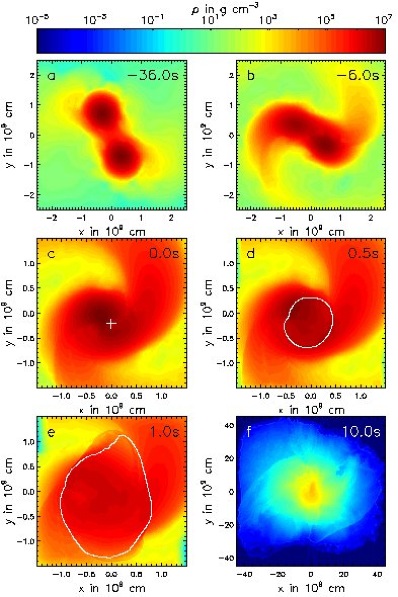
Merging white dwarfs become supernovae
DR EMILY BALDWIN
ASTRONOMY NOW
Posted: 07 January 2010


New computer simulations confirm that some Type Ia supernova explosions are caused by the merging of two binary white dwarf stars.
Supernovae are caused by a variety of mechanisms – most stars die when their fuel runs out and their cores collapse in on themselves, while the most massive stars are thought to explode when their centres become so hot that matter and anti-matter particle pairs create a runaway thermonuclear reaction. White dwarfs, the compact cores of dead stars, can also undergo runaway nuclear fusion by accreting material from a companion star. Now, computer simulations show that supernova events can also result from the merging of two white dwarf stars.
 Snapshots of the merger of two equal size white dwarf stars from 36 seconds prior to the explosion until 10 seconds afterwards. The colour-coding indicates the density of material, which is increasing from blue to red. Please note the different scaling on the plots. Image: Max Planck Institute for Astrophysics. Snapshots of the merger of two equal size white dwarf stars from 36 seconds prior to the explosion until 10 seconds afterwards. The colour-coding indicates the density of material, which is increasing from blue to red. Please note the different scaling on the plots. Image: Max Planck Institute for Astrophysics.
Once they have exhausted their hydrogen and helium fuel, intermediate mass stars like our own Sun end their lives as white dwarfs consisting of carbon and oxygen. In a binary system, two white dwarfs will form, and as they lose energy their orbits shrink inwards, ultimately resulting in a cataclysmic union.
Astronomers have long speculated that such an event would produce a Type Ia supernovae, and the detailed simulations show just that. In the example of the collision of two equal mass white dwarfs, part of the material of one dead star crashes into the other, heating up the carbon-oxygen mix such that a thermonuclear explosion disrupts the star in a spectacular supernova event.
“Supernovae are among the brightest observed cosmic explosions,” says Wolfgang Hillebrandt, director at the Max Planck Institute for Astrophysics. “How they form, however, remains largely unknown. With our simulations we have now shed light on at least part of the old riddle of the progenitors of Type Ia supernovae.”
The team matched the results of the simulations to the properties of real Type Ia supernovae, although the merging of two white dwarfs cannot account for all Type Ia explosions.
|



